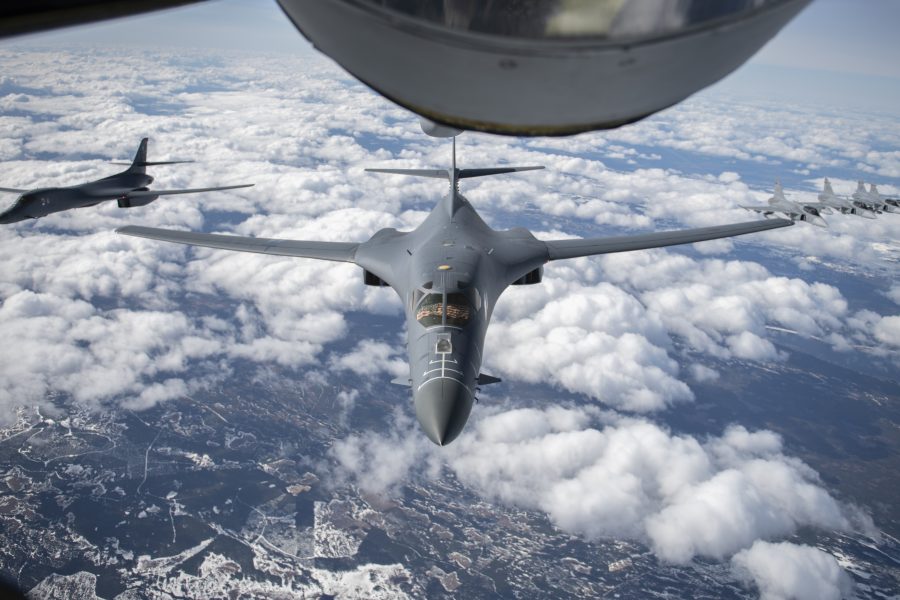House and Senate Conferees require a larger Air Force in the final version of the fiscal 2021 defense policy bill, directing the service to build the 386 combat squadrons it said it needs to meet the National Defense Strategy, and specifically raising the bomber fleet to 225 aircraft, as USAF leaders and various think-tanks have suggested over the last year.
The 3,580-aircraft fleet constitutes a “moderate risk aviation force structure,” and the Air Force can only reduce the number of extant airplanes if it certifies that some of them have been damaged beyond economical repair, or that increased effectiveness, as certified by the Joint Chiefs of Staff, meets the required level of capability. The new numbers will stand through fiscal 2025.
“The conferees agree that the current quantity of Air Force combat-coded aircraft incurs a level of risk beyond moderate, and is not aligned with the National Defense Strategy,” according to the joint language. “Multiple, independent, and department-wide studies” bear out this conclusion and recommend similar levels of aircraft in order to achieve a “moderate risk” force as defined by the Chairman of the Joint Chiefs of Staff in the “Joint Risk Analysis” manual.
The Senate set specific inventory levels in its version of the bill, while the House set only the overall number, with the conference adopting the Senate language. Both chambers must still approve the bill, and the President must sign it before the National Defense Authorization Act becomes law.
The language would put into law the Air Force’s unofficial recommendations over the last year that the bomber fleet, now at 157 aircraft, be expanded to 225 airframes, and the number of primary mission aircraft inventory—those ready to go at a moment’s notice—is not to fall below 92 airframes. These new minimums are also set through fiscal 2025.
“The long ranges, large payloads, and multi-mission capabilities of bombers are exactly the kind of attributes theater commanders need to deter aggression,” writes retired Col. Mark Gunzinger, director for future aerospace concepts and capabilities assessments at AFA’s Mitchell Institute for Aerospace Studies in the December issue of the magazine. “However, multiple studies have concluded the current bomber force cannot generate enough conventional strike sorties for a single major conflict with a peer adversary plus sustain nuclear deterrence simultaneously, and thus recommended the Air Force grow the inventory as quickly as possible … In short, a larger and more balanced mix of penetrating and standoff bombers is needed.”
The conferees agreed the B-1 fleet, which stand at 62 airplanes overall, of which 36 are combat coded, be reduced by 12 combat-coded aircraft, to 24. The Air Force had requested the retirement of 17 B-1s, with plans to use the savings to upgrade and operate the remaining aircraft at a higher readiness level. Four B-1s that are retired to the “boneyard” at Davis-Monthan Air Force Base, Ariz., are to be kept in Type 2000, or recallable storage, to ensure their parts can be used.
The conferees decided to require that a maintenance capability for the B-1 be maintained until the B-21, the Air Force’s next stealth bomber, “is fielded.”
Long-range strike with standoff weapons “will be principally conducted by the B-1 Lancer and B-52 Stratofortress bombers over the next decade,” the conference said. Members “believe it is imperative to provide a legacy bomber modernization program that is commensurate with the intended service life.”
The Air Force is to provide a “roadmap” by Feb. 1, 2021, explaining how its bomber force structure will “meet the requirement of its long-range strike mission” under the NDS. Specifically, the Air Force is to state the total minimum number of bombers it needs and the minimum number of those to be counted as primary mission aircraft.
USAF also must explain how much of the bomber force needs to be capable of penetrating enemy air defenses, and the minimum number of bombers it requires for this mission, both overall and combat-coded. The B-1 and B-52 are deemed no longer capable of penetrating modern air defenses and are expected to be relegated to a standoff role. Specific dates are to be stated for when the Air Force would achieve all these levels of bomber inventory. USAF is to submit both a classified and publicaly releasable version of the roadmap.
The minimum numbers of airplanes for the Air Force set by the NDAA are as follows:
| Aircraft Type | Number Required |
| Fighters | 1,680 |
| Persistent attack remotely piloted aircraft | 199 |
| Bombers | 225 |
| Aerial Tankers | 500 |
| Tactical Airlifters | 286 |
| Strategic Airlifters | 284 |
| Command and Control aircraft | 55 |
| Combat Search and Rescue aircraft | 105 |
| Intelligence, Surveillance, Reconnaissance aircraft | 30 |
| Special Operations aircraft | 179 |
| Electronic Warfare aircraft | 40 |
The conferees set 287 as the minimum number of C-130-type aircraft as the minimum total number, with 230 to be the number of primary mission aircraft available at any given time. The Secretary of the Air Force can reduce that number only if an upcoming Mobility Capability Requirements Study shows that a smaller number will suffice. Any excess are to be transferred to “an alternative flying mission.”
The conferees said they were “encouraged” by the Air Force’s efforts to find a solution for the KC-46 tanker’s remote vision system, which is preventing initial versions of the aircraft from being used as tankers. Until the solution is implemented, though, the conferees limited the Air Force to retiring eight KC-10 Extender refueling airplanes in the remainder of this year, then 12 per year for the next two years, and the remaining 26 in fiscal 2023. The Air Force can’t spend any money to retire KC-135s, either, and must maintain a fleet of 412 tankers as the primary mission aircraft inventory.
